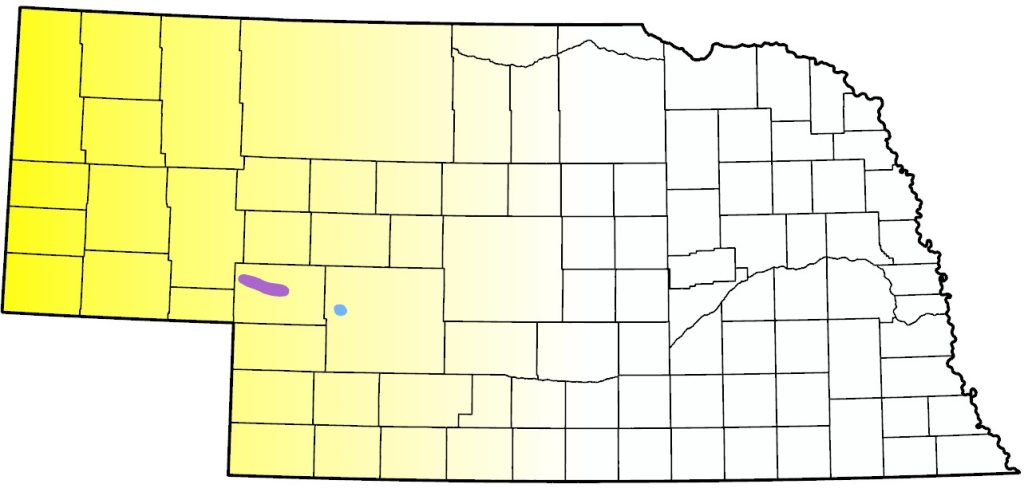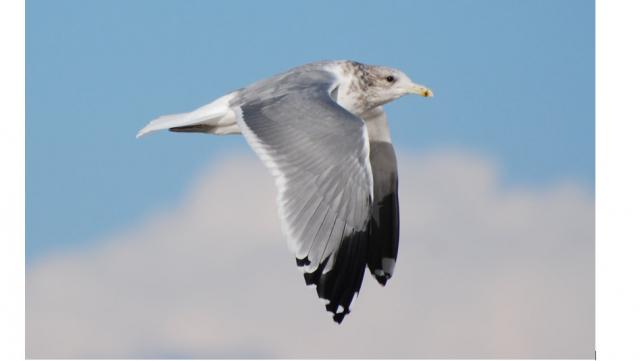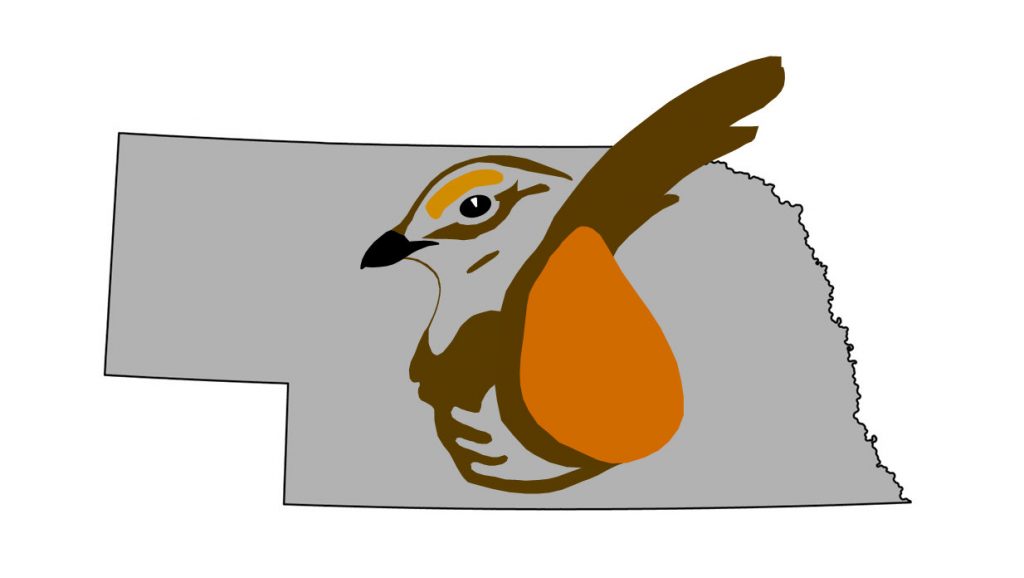Larus californicus californicus, L. c. albertaensis
Status: Fairly common regular spring and fall migrant North Platte River Valley in Keith and Lincoln Cos, uncommon elsewhere North Platte River Valley, rare elsewhere southern Panhandle, rare casual elsewhere. Locally uncommon regular summer and winter visitor North Platte River Valley (Keith and Lincoln Cos), rare casual elsewhere.

Documentation: Photograph: 14 Aug 1986 Lake McConaughy, Keith Co (Brogie 1986; Mollhoff 1989).
Taxonomy: There are two subspecies of California Gull (Jehl 1987, Gill et al 2022), californicus, breeding locally from British Columbia south to California and central Colorado, and albertaensis, breeding in central Canada and the north-central and northwestern United States. There is a zone of overlap in Montana (Winkler 2020, Howell and Dunn 2007). Field identification of the subspecies is difficult (see Comments).
Both subspecies occur in Nebraska. Increased late summer and early fall numbers at Lake McConaughy are most likely immature non-breeders or possibly failed breeders of californicus from Colorado; californicus is undocumented elsewhere in Nebraska. Leukering (post to COBIRDS 3 Dec 2010) stated that at least 80% of California Gulls in Colorado are californicus. We consider albertaensis to comprise most if not all spring and fall migrants through Nebraska east of and/or away from the North Platte River Valley; both subspecies would be expected at Lake McConaughy during albertaensis migration periods (Mar-Apr and Oct-Dec).
There are three band recoveries involving albertaensis; one banded in Montana 8 Jul 1940 and two banded in North Dakota 9 Aug 1964 were recovered at Valentine NWR, Cherry Co 4 Oct 1940, in Hooker Co 14 Sep 1964, and in Deuel Co 26 Sep 1964 respectively. Banding results support the occurrence of the species (presumably albertaensis) in the Interior (Houston 1977, Gaston et al 2008), although Gaston et al (2008) pointed out that chicks of Ring-billed Gull and California Gull are essentially indistinguishable at time of banding and the two species often breed in the same colonies, thus casting some doubt as to whether banded adults assumed to be California Gulls (for example recoveries in Louisiana) are indeed the latter species.
There may be some southward movement of californicus in winter to the southern Great Plains (Gaston et al 2008); Robbins (2020), while noting that information on subspecies in Missouri is minimal, stated: “Most are likely of the nominate subspecies, however, two … observations, 18 Jan 1999 (Stockton Lake) and 13 Feb 2019 (Longview Lake), may be attributable to the more northern albertaensis“. Both subspecies have been collected in Louisiana (Mark Robbins, personal communication). Supporting the possibility of eastward vagrancy by californicus are several Great Lakes records and one for Florida (eBird.org, accessed Dec 2023).
A well-described and -photographed bird at Branched Oak Lake 5 Apr 2019 was noted to have a darker bill than same-age birds in California, raising the possibility that interior California Gulls (albertaensis) may differ in this respect (Noah Arthur, eBird.org).
Spring: Mar 13, 13, 14 <<<>>> May 27, 30, Jun 1 (away from North Platte River Valley)
Early and late dates cited above are from locations away from Keith and Lincoln Cos; California Gulls can be found at Lake McConaughy year-round. For Jan-early Mar records away from the North Platte River Valley see Winter.
Later dates are cited in Summer, below.
Spring records in Nebraska are most likely a mix of migrants of albertaensis and summering non-breeders of californicus (see Taxonomy, above). California Gull reports on eBird.org increase markedly in northeastern Colorado during Mar and Apr, with numerous records extending down the South Platte River Valley to the Lake McConaughy area in Nebraska.
Of 35 records Jan-Jun of California Gull away from the North Platte River Valley, one each are for Jan and Feb, 12 in Mar, seven in Apr, 10 in May, and four in Jun. Such records away from the North Platte River Valley would be expected to be mostly of migrant albertaensis; most are for Mar-May.
In 2014 reports were indicative of a surprising influx in eastern Nebraska of birds of all age groups, although many of the reports, unfortunately, were not supported by unequivocal photographs, particularly of birds in flight; there were at least five birds at four locations 13 Mar- 5 May (Silcock 2014).
- High counts: 82, mostly adults, at Lake McConaughy 22 Apr 1994, and 27 there 17 Apr 1997.
Summer: Breeding occurs close to Nebraska at several sites in northeastern Colorado; no estimate of breeding pairs was given by Wickersham (2016), but up to 1500 pairs of the nominate race californicus were nesting at Riverside Reservoir in Weld Co around 2000 (Mark Robbins, personal communication). Breeding also occurs in northern South Dakota (Tallman et al 2002). In Colorado, islands are used for nesting (Andrews and Righter 1992); the lack of islands at Lake McConaughy may obviate breeding there. Because of the proximity of these breeding colonies to Nebraska, we presume that most summer records at Lake McConaughy are of californicus.
Midsummer reports in Nebraska, those in the period Jun through Aug, are few and recent; the two reports prior to 1995 were at Lake McConaughy, 13 Jun 1987 an adult in Keith Co, presumably at Lake McConaughy (Williams 1987), and 15 Jun 1991, a mixed age flock of 10. Since 1995 there have been about 65 records for the North Platte River Valley, with at least one bird has been reported each summer and numbers reaching the 20-30 range in some years since 2004.
Away from the North Platte River Valley, the only mid-summer (Jun-Aug) records are of a “near adult” 15 Jun 2002 at Branched Oak Lake, Lancaster Co, 8 Jul 2006 (3) Valentine NWR, Cherry Co, 1 Aug 2024 Crescent Lake NWR, Garden Co, and 7 Aug 2020 Scotts Bluff Co.
Age classes are of interest and suggest presence of failed breeders and non-breeding immatures. The 21 counted at Lake McConaughy 20 Jun 2004 consisted of eight adults, 11 second alternate, and one first alternate-plumaged birds, and the 30 on 21 Jun 2005 included 19 adults, six second-alternate, and five first-alternate birds (Stephen J. Dinsmore, personal communication).
Fall: Numbers of California Gulls increase at Lake McConaughy during late summer beginning in Jul. A good early count was a flock of 84 there 19 Jul 2003, consisting of 17 adults and the rest molting near-adults (Silcock 2003). Another good count of perhaps similar provenance was the 80 there on 30 Jul 2006, including 70 adults, eight juveniles, and single first- and second-alternate birds (Stephen J. Dinsmore, personal communication). Numbers continue to build into fall, presumably as summering birds are joined by northern prairie breeders and then decrease in early to mid-winter, with sizeable numbers still present into late Dec. Of an approximate total of 474 birds reported to eBird.org in all years through spring 2022 at Lake McConaughy, 81% were present Aug-Dec.
Away from the North Platte River Valley, there are 14 records Sep-Dec: 26 Sep 2021 Branched Oak Lake, Lancaster Co, 29 Sep 2019 Gavn’s Point Dam area in Cedar and Knox Cos, 10 Oct 2022 Whitney Lakes, Dawes Co,14 Oct 2024 Sherman Reservoir, Sherman Co, 16 Oct 2016 Swanson Reservoir, Hitchcock Co, 24 Oct 2015 Harlan County Reservoir, Harlan Co, 25 Oct 2019 Branched Oak Lake, 2-9 Nov 2019 Gavin’s Point Dam area, 10 Nov 2018 Gavin’s Point Dam area, 12 Nov 2001 Gosper Co, 14-16 Nov 2024 Knox Co, 28-29 Nov 2014 Gavin’s Point Dam area, 8-9 Dec 2024 Johnson Lake, Gosper Co, 10-14 Dec (3) Branched Oak Lake, and 14 Dec 2017 Harlan County Reservoir.
- High counts: 151 at Lake McConaughy 24 Aug 2007, 148 there 4-11 Aug 1996, and 148 there 5 Nov.
Winter: Overwintering attempts apparently first occurred 1991-1992 at both Lake McConaughy and Sutherland Reservoir; an adult was at Lake McConaughy 16 Feb and three were at Sutherland Reservoir 15 Feb (Morris 1992). Similar observations were of 1-2 remaining at Lake McConaughy 19 Feb 1995, and 20 there 1 Feb 1997 but only 1 on 15 Feb. Some Feb records may be of returning birds; in 1997-98, 78 were present 1 Jan, but none 14-15 Jan, although 38 had reappeared by 7 Feb. Overwintering was first confirmed at Lake McConaughy 1995-1996, when 26 were present 28 Jan 1995 and 21 on 5 Feb 1996, but only three remained 5 Mar.
Since these records, overwintering in Keith and Lincoln Cos, mostly at Lake McConaughy and Sutherland Reservoir, has occurred each year; lowest numbers are Jan-early Mar.
The only mid-winter (Jan-early Mar) records away from Keith and Lincoln Cos are of an adult at Twin Lakes WMA, Seward Co 27 Jan 2015, 17 Feb 2015 Lancaster Co, 19 Feb 2017 an adult at Lakes North and Babcock, Platte Co, 26 Feb 2012 (3) Johnson Lake, Dawson/Gosper Cos, 3 Mar 2017 (3) Gosper Co, 4 Mar 2015 Lincoln Co, 8 Mar 2013 Arthur Co, and 10 Mar 2020 Oliver Reservoir, Kimball Co.
Comments: Identification in the field of the two subspecies is difficult. According to Tony Leukering (post to COBIRDS), “the only character that allows fairly certain differentiation of subspecies, and this ONLY on full adults, is the precise wing tip pattern (Pyle 2008): californicus has black on outer primaries extensive, that on outer web of p7 occasionally (~13% of individuals) and p8 often (~56%) reaching primary coverts, and albertaensis has black on outer primaries reduced, that on outer web of p7 not reaching primary coverts and on p8 only occasionally (~15%) reaching primary coverts. Complicating matters is reported hybridization with Herring Gull in Colorado (another) (Andrews and Righter 1992) and possible intergradation between the two subspecies in Montana (Howell and Dunn 2007).
Most of the history of this species in Nebraska has been focused on Lake McConaughy, where it was first reported 25 Jul 1984 (Williams 1984b) and first documented in 1986 (cited above). By 1989 there were 14 observations (Rosche 1994), and since 1990, California Gull had become “almost a permanent resident” (Rosche 1994).
Nebraska’s first report of a California Gull is of a bird captured in Howard Co Nov 1934 which had been banded in Montana 17 Jun 1934; no identification details have been published. Through the early 1980s, there were very few reports: Shickley (1966, 1968) reported birds in Lincoln Co 25 Oct 1965 and 19-20 Oct 1967. Rosche (1982) noted four sightings at Whitney Lake, Dawes Co 19 Mar-10 Apr in the years 1974-76 and one at Box Butte Reservoir, Dawes Co 4 Oct 1975; another was reported in Dawes Co 23 Mar 1974. During the 1980s there were additional reports from Dawes and Keith Cos in the period 18 May-19 Aug (Williams 1984a, 1984b, 1985, 1987; Grzybowski 1990; reports 11 and 25 Jul 1984 were considered “astonishing” due to the species’ rarity (Williams 1984b). In addition, there are reports in the 1980s for Cherry Co 21 Mar 1980 and Lincoln Co 18 May 1986.
A specimen collected by Hudson in Lancaster Co 19 Mar 1933 (Hudson 1933) is now an axial skeleton, UNSM ZM11152, but Hudson (1956) later retracted the report, concluding that the measurements did not eliminate the possibility of the specimen being a small Herring Gull.
Images
Abbreviations
NWR: National Wildlife Refuge
UNSM: University of Nebraska State Museum
WMA: Wildlife Management Area (State)
Literature Cited
Andrews, R., and R. Righter. 1992. Colorado birds. Denver Museum of Natural History, Denver, Colorado, USA.
Brogie, M.A. 1986. California Gull in Keith County, Nebraska. NBR 54: 77.
Gaston, A.J., D. Brewer, A.W. Diamond, E.J. Woodsworth, and B.T. Collins. 2008. Canadian Atlas of Bird Banding Volume 2: Seabirds, 1921–1995 Special Publication Canadian Wildlife Service. pp 80-83. http://publications.gc.ca/collections/collection_2011/ec/CW69-20-2-2-2008-eng.pdf.
Gill, F., D. Donsker, and P. Rasmussen (Eds). 2022. IOC World Bird List (v 12.2). Doi 10.14344/IOC.ML.12.2. http://www.worldbirdnames.org/.
Grzybowski, J.A. 1990. Southern Great Plains Region. American Birds 44: 454-457.
Houston, C.S. 1977. Movements of Saskatchewan banded Calfornia Gulls. Bird Banding 48: 158-161. https://www.jstor.org/stable/20699079?
Howell, S.N.G., and J. Dunn. 2007. Gulls of the Americas. Houghton Mifflin Harcourt, New York, New York, USA.
Hudson, G.E. 1933. A Nebraska record of the California Gull. NBR 1: 61.
Hudson, G.E. 1956. Error. NBR 24: 54.
Jehl, J.R. Jr. 1987. Geographic variation and evolution in the California Gull (Larus californicus). Auk: 104: 421-428.
Mollhoff, W.J. 1989. Second report of the NOU Records Committee. NBR 57: 42-47.
Morris, R. 1992. Spring 1992 Occurrence Report. NBR 60: 79-149.
Pyle, P. 2008. Identification Guide to North American Birds. Part II, Anatidae to Alcidae. Slate Creek Press, Bolinas, California, USA.
Robbins, M.B. 2020. The Status and Distribution of Birds in Missouri. Second Edition. University of Kansas Biodiversity Institute, Lawrence, Kansas, USA.
Rosche, R.C. 1982. Birds of northwestern Nebraska and southwestern South Dakota, an annotated checklist. Cottonwood Press, Crawford, Nebraska, USA.
Rosche, R.C. 1994. Birds of the Lake McConaughy area and the North Platte River valley, Nebraska. Published by the author, Chadron, Nebraska, USA.
Shickley, G.M. 1966. Excerpts from letters. NBR 34: 40.
Shickley, G.M. 1968. Additions to Lincoln County checklist. NBR 36: 54-57.
Silcock, W.R. 2003. Summer Field Report, June-July 2003. NBR 71: 106-127.
Silcock, W.R. 2014. Spring Field Report, Mar 2014 to May 2014. NBR 82: 46-73.
Tallman, D.A., Swanson, D.L., and J.S. Palmer. 2002. Birds of South Dakota. Midstates/Quality Quick Print, Aberdeen, South Dakota, USA.
Wickersham, L.E. Ed. 2016. The Second Colorado Breeding Bird Atlas. Colorado Bird Atlas Partnership, Colorado Parks and Wildlife, Denver, Colorado, USA.
Williams, F. 1984a. Southern Great Plains Region. American Birds 38: 929-931.
Williams, F. 1984b. Southern Great Plains Region. American Birds 38: 1035-1037.
Williams, F. 1985. Southern Great Plains Region. American Birds 39: 72-75.
Williams, F. 1987. Southern Great Plains Region. American Birds 41: 1455-1458.
Winkler, D.W. 2020. California Gull (Larus californicus), version 1.0. In Birds of the World (A. F. Poole and F. B. Gill, Editors). Cornell Lab of Ornithology, Ithaca, NY, USA. https://doi.org/10.2173/bow.calgul.01.
Recommended Citation
Silcock, W.R., and J.G. Jorgensen. 2025. California Gull (Larus californicus). In Birds of Nebraska — Online. www.BirdsofNebraska.org
Birds of Nebraska – Online
Updated 7 Jun 2025, map updated 29 Jun 2022

